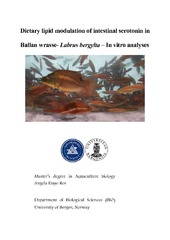| dc.contributor.author | Etayo, Angela Ros | |
| dc.date.accessioned | 2018-09-04T14:56:46Z | |
| dc.date.available | 2018-09-04T14:56:46Z | |
| dc.date.issued | 2018-09-04 | |
| dc.date.submitted | 2018-09-03T22:00:02Z | |
| dc.identifier.uri | https://hdl.handle.net/1956/18375 | |
| dc.description.abstract | Salmon lice infections by Lepeophtheirus salmonis represent one of the biggest challenges for the salmon industry. Intensive use of chemical delousing methods has led to resistance in lice against several of the chemicals, this has sparked an interest for the use of cleaner fish as an efficient delousing solution. A goal for several salmon farmers is that farmed cleaner fish should replace wild catches, this has led to commercial farming of Ballan wrasse. In order to optimize the cultivation, knowledge about B. wrasse digestive physiology (normal functioning and regulation) and its nutritional requirements are equally important. Serotonin (5-HT) has been proposed to be an important molecule at regulating gut motility involved in digestion of nutrients as well as appetite regulation. Serotonin function in B. wrasse is unknown, elucidating its role might contribute to a better understanding of the gastrointestinal functionality that might help to overcome farming limitations of this cultured specie. There were two separate aims of this study. A transcriptomic part; revealing the expression of genes in the intestine regulated by lipid ingestion, emphasizing genes associated to lipid and 5-HT metabolism. Here, the aim was to observe the dietary lipid modulation of the gene expression over time (post prandial incubation time from 10m to 3 hours). In addition to this, my aim was to investigate the amount of 5-HT in the gut of Ballan wrasse from the same intestines to detect potential correlation to gene expressions involved in 5-HT metabolism. These investigations were done, in vitro on ex vivo intestines of Ballan wrasse, using a lipid diet (hydrolysed fish oil). Results showed significant response of only one gene involved in 5-HT metabolism (TPH2) and 3 genes involved in lipid metabolism after feeding (ELOVL1, PLIN2 and PPARG). Interestingly enough, 5-HT was observed to be present in the gut of Ballan wrasse with a tendency to increase 3 hours after feeding. Also, by analysing genome and transcriptomic data, I propose the presence of enterocromaffin cells (EC cells) in the gut of B. wrasse. EC cells theoretically, produce the majority of intestinal 5-HT synthesized through the enzyme TPH1. Unlike TPH1, its isoform TPH2 (exclusive to enteric neurons, another 5-HT producing cell) was observed to be significantly upregulated by feeding, suggesting an active role in nutrient sensing. | en_US |
| dc.language.iso | eng | eng |
| dc.publisher | The University of Bergen | en_US |
| dc.subject | Fiskefysiologi | nob |
| dc.subject | Serotonin | nob |
| dc.subject | Lipider | nob |
| dc.subject | Metabolisme | nob |
| dc.subject | Berggylt | nob |
| dc.subject | Fordøyelsen | nob |
| dc.title | Dietary lipid modulation of intestinal serotonin in Ballan wrasse- Labrus bergylta – In vitro analyses | en_US |
| dc.type | Master thesis | |
| dc.date.updated | 2018-09-03T22:00:02Z | |
| dc.rights.holder | Copyright the Author. All rights reserved | en_US |
| dc.description.degree | Master's Thesis in Biology | en_US |
| dc.description.localcode | MAMN-BIO | |
| dc.description.localcode | BIO399 | |
| dc.subject.realfagstermer | https://data.ub.uio.no/realfagstermer/c006053 | |
| dc.subject.realfagstermer | https://data.ub.uio.no/realfagstermer/c012645 | |
| dc.subject.realfagstermer | https://data.ub.uio.no/realfagstermer/c032050 | |
| dc.subject.realfagstermer | https://data.ub.uio.no/realfagstermer/c007901 | |
| dc.subject.realfagstermer | https://data.ub.uio.no/realfagstermer/c013661 | |
| dc.subject.realfagstermer | https://data.ub.uio.no/realfagstermer/c000459 | |
| dc.subject.nus | 751999 | eng |
| fs.subjectcode | BIO399 | |
| fs.unitcode | 12-60-0 | |
